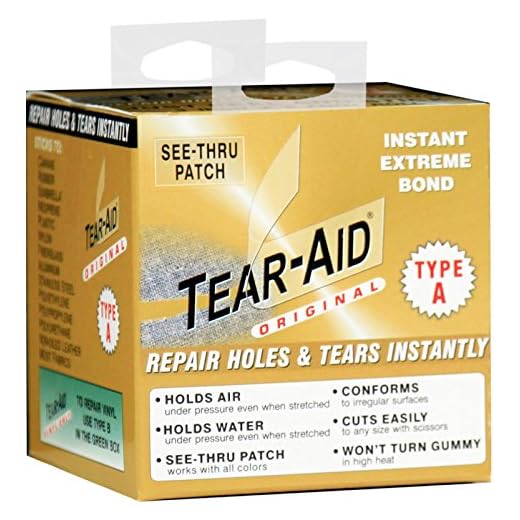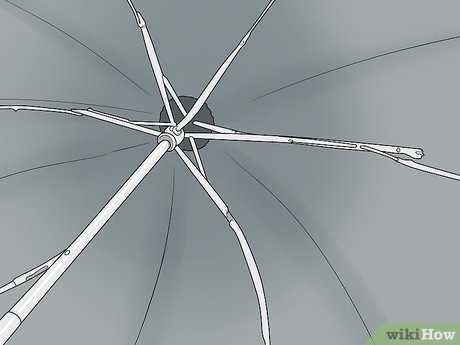




To address a breach on your canopy, begin by cleaning the affected area with mild soap and water. Allow it to dry completely before proceeding. This initial step is critical for ensuring that any adhesive used will bond properly.
Next, consider using a fabric repair tape designed for outdoor gear. Cut a piece slightly larger than the damaged section, and apply it smoothly over the area, ensuring no air bubbles remain. Press firmly for a secure hold, and allow it to set according to the manufacturer’s instructions.
This article serves as a practical guide for anyone looking to maintain their outdoor equipment. Whether you’re a casual user or someone who frequently relies on such gear, these straightforward steps can extend the life of your canopy and save you from unnecessary expenses.
By following these tips, you can effectively restore functionality to your outdoor equipment, ensuring it remains a reliable companion during rainy days. Don’t let minor damages ruin your experience; take action and keep enjoying your time outdoors.
Repairing a Fabric Flaw on an Umbrella
To address a fabric flaw on your canopy, consider using a fabric adhesive patch designed for outdoor gear. This method provides a waterproof seal and ensures durability against the elements.
Begin by cleaning the area around the damage with rubbing alcohol to remove any dirt or oils. Once dry, cut a patch from a similar fabric, ensuring it extends at least half an inch beyond the edges of the flaw.
Steps to Repair
- Apply a thin layer of adhesive to the back of the fabric patch.
- Carefully position the patch over the damaged area, pressing firmly to eliminate air bubbles.
- Use a heavy object to weigh down the patch for several hours to ensure a solid bond.
- After curing, check the edges of the patch for any lifting. If necessary, apply more adhesive to secure the edges.
Alternatively, for a quicker fix, consider using waterproof tape. Cut a piece larger than the imperfection, and firmly apply it to the affected area. This option is excellent for temporary repairs until a more permanent solution is feasible.
Regular inspections and maintenance can prolong the life of your canopy, ensuring it remains functional and stylish for many seasons.
Assessing the Damage: Identifying the Tear Type
Begin by closely examining the affected area to determine the nature of the damage. Different types of fabric ruptures require specific approaches to restoration. Identifying the tear characteristics is essential for selecting the most suitable remedy.
Look for key features such as the tear’s size, shape, and location. A small, clean cut may necessitate a different approach compared to a jagged or larger opening. Additionally, consider whether the damage is in a high-stress area, which could affect the longevity of any repair.
Types of Damage
- Clean Cuts: These are straight and well-defined, often easy to fix with adhesive patches or sewing.
- Jagged Rips: Irregular edges may require more careful treatment, possibly involving stitching to secure the fabric before applying any patch.
- Holes: Small punctures might be handled with fabric glue or specialized patches, while larger ones could need a more robust solution.
Understanding the type of damage will guide the selection of materials required for repair. For instance, lightweight fabrics might need a different adhesive compared to heavier materials. Proceed with caution, as improper assessment can lead to ineffective repairs.
Choosing the Right Repair Materials for Umbrella Fabric
Selecting appropriate materials for mending fabric is critical for ensuring longevity and functionality. The choice of fabric can greatly impact the durability of the repair. Look for materials that are water-resistant and can withstand outdoor conditions.
Consider using fabric patches made from similar materials to the original canopy. This helps maintain the aesthetic and functional qualities of the structure. Additionally, adhesive products that are specifically designed for outdoor fabrics will provide a strong bond and flexibility.
Types of Materials to Consider
- Fabric Patches: Look for patches made from polyester or nylon, as they offer excellent weather resistance.
- Adhesives: Use waterproof fabric glue or tape that is designed for outdoor use to ensure a secure hold.
- Seam Sealants: These can be applied to the edges of patches to prevent water ingress.
When applying a patch, ensure that the surface is clean and dry. For best results, trim the patch to a rounded shape to minimize lifting at the edges. After applying the patch, press firmly and allow sufficient time for the adhesive to cure before exposing it to moisture.
In some cases, stitching may be necessary for added security. Use a needle and thread that are suitable for outdoor use. A zigzag stitch can provide elasticity and help prevent fraying.
| Material | Benefits |
|---|---|
| Polyester Patch | Durable, water-resistant |
| Nylon Patch | Strong, lightweight |
| Waterproof Adhesive | Strong bond, flexible |
By carefully choosing the right materials, you can ensure that your repairs are robust and effective, extending the life of your fabric structure.
Step-by-Step Guide to Applying a Fabric Patch
To mend a small opening in your canopy, first gather necessary materials such as fabric glue, a piece of fabric for the patch, scissors, and a clean cloth. Ensure the area around the damage is clean and dry before proceeding.
Begin by cutting a piece of fabric slightly larger than the damaged section. This provides ample coverage and helps secure the surrounding material. Choose a fabric that closely matches the original for a seamless appearance.
Application Process
- Prepare the Surface: Clean the area around the opening with a damp cloth to remove dirt and debris. Allow it to dry completely.
- Cut the Patch: Trim the patch to size, ensuring it extends at least half an inch beyond the edges of the damage.
- Apply Adhesive: Use fabric glue on the back of the patch, spreading it evenly. Be careful not to apply too much, as excess glue may seep out during application.
- Position the Patch: Center the patch over the damaged area and press down firmly. Ensure there are no air bubbles or wrinkles.
- Secure the Edges: Run your fingers around the edges of the patch to ensure a strong bond. This step is crucial for longevity.
- Allow to Dry: Follow the glue manufacturer’s instructions for drying time. Avoid using the item until fully set to ensure a strong hold.
This method will help restore function and appearance to your item, ensuring it remains reliable for future use.
Using Adhesives: Tips for a Strong Bond
For a reliable repair, select an adhesive designed specifically for fabric applications. Look for options that provide flexibility after curing, ensuring the patch remains intact during use. Read the instructions carefully to understand the curing time and application method.
Before applying the adhesive, ensure the surfaces are clean and dry. Use a mild detergent to remove any dirt or grease, then allow the area to air dry completely. This preparation step is crucial for achieving a strong bond.
Application Techniques
When applying the adhesive, follow these guidelines:
- Apply Evenly: Spread a thin, even layer of adhesive on both surfaces to maximize contact.
- Use Pressure: After joining the pieces, apply firm pressure for the recommended time to ensure they adhere well.
- Avoid Excess: Use only the amount needed to prevent overflow, which can weaken the bond.
For added strength, consider using a reinforcing patch made of a compatible fabric. Cut the patch slightly larger than the area needing repair and apply it over the adhesive. This extra layer can enhance durability.
Allow the adhesive to cure fully before using the repaired item. This patience ensures the bond achieves its maximum strength, providing peace of mind during use.
Maintaining Your Canopy After the Repair
To extend the lifespan of your repaired canopy, regular maintenance is necessary. This involves cleaning and proper storage to prevent future damage.
Begin by gently wiping down the fabric with a damp cloth to remove dirt and debris. Avoid using harsh chemicals that could weaken the material. After cleaning, let it air dry completely before folding.
- Store your canopy in a cool, dry place, away from direct sunlight. Prolonged exposure to UV rays can degrade the fabric over time.
- Always ensure that the ribs and frame are free from rust or corrosion. Apply a light lubricant to moving parts to maintain functionality.
- Inspect the repaired area periodically. If you notice any signs of wear, address them immediately to prevent further damage.
By following these steps, you can keep your shelter in excellent condition for many seasons ahead.
Best way to patch a tear on a new umbrella
Features
| Part Number | BR-Liferong-Black-89*200 |
| Color | Suede Black |
| Size | 35X79 Inch |
Features
| Part Number | TG-128 |
| Model | TG-128 |
| Color | Clear |
| Size | 1 Gallon |
Features
| Part Number | TA-D-ROLL-A-2 |
| Model | TA-D-ROLL-A-2 |
| Color | Clear |
| Size | 3 x 5.5 inches |
| Language | English |
Features
| Part Number | BR-SGymbu-Black-89*200 |
| Color | Linen Black |
| Size | 35X79 Inch |
Features
| Part Number | FTL-LOG-W-001 |
| Color | Red |
Video:
FAQ:
What materials are best for patching a tear on an umbrella?
When patching a tear on an umbrella, suitable materials include fabric patches made from nylon or polyester, which are durable and weather-resistant. You can also use waterproof adhesive tape, which is easy to apply and provides a strong bond. For minor tears, a fabric repair glue specifically designed for outdoor gear can be effective. Make sure the materials you choose match the umbrella’s fabric for optimal results.
Can I use regular duct tape to fix a tear on my umbrella?
While regular duct tape can provide a temporary fix for a tear, it is not the best long-term solution for an umbrella. Duct tape may not adhere well to wet surfaces or withstand outdoor conditions for long periods. If you choose to use duct tape, ensure the area is dry and clean before applying it. For a more durable repair, consider using a fabric patch or waterproof tape designed specifically for outdoor use.
How do I apply a fabric patch to my umbrella tear?
To apply a fabric patch to a tear on your umbrella, first clean the area around the tear to ensure good adhesion. Cut a patch from a suitable fabric, making it at least an inch larger than the tear on all sides. If using fabric glue, apply a thin layer to the patch and press it firmly onto the tear. For a more secure hold, you can sew the patch around the edges after the glue has dried. Ensure the umbrella is completely dry before using it again.
Is it possible to repair a large tear in my umbrella, or should I replace it?
Repairing a large tear in an umbrella is often possible, depending on its size and location. If the tear is manageable and you can securely patch it using the right materials, your umbrella can be restored to functionality. However, if the damage is extensive or compromises the structure, it may be more practical to replace the umbrella. Assess the repair cost versus the price of a new umbrella to make the best decision.







